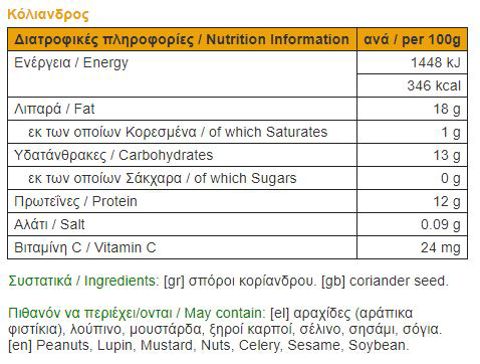FREE SHIPPING & DISCOUNTS
Free shipping on orders over 90 euros, enjoy 5% discount on orders over 40 euros. Get an additional 3% off on orders over 60 euros
shipping & paymentsCoriander is a small, hollow-stemmed plant in the Coriandum genus. Pleasant, aromatic, spicy and flavorful the plant's small seeds have found utility since ancient times in cooking as well as in various traditional medecines. All parts of the plant are edible, but the fresh leaves and the dried seeds are the parts most traditionally used in cooking.
Coriander is native to South-Eastern Europe and it grows extensively all over Europe, Middle East, China, India and Turkey. In the west it is recognized as cilantro and the Chinese name it as Chinese parsley, as the plant's strong aroma and flavor bear a resemblance to parsley. Generally, it grows wild in nature and there have been recorded mentions of the plant and spice all over the world. Over the numerous reports about the plant, one of the most important is the one about a finding of coriander in the Pre-Pottery Neolithic B level of the Nahal Hemar Cave in Israel, which seems to be the oldest archeological find of coriander. It was also discovered inside the tomb of Tutankhamen and arceologists believe this to be proof the plant had been cultivated by the ancient Egyptians.
Coriander seems to have been cultivated in Greece as well, since at least the second millenium BC. In one of the Linear B tablets recovered from Pylos, it is suggested that coriander was being cultivated for the manufacture of perfumes and either the seeds were used as a spice or the leaves for their flavor and aroma in cooking.
The fresh leaves find utility in Chinese, Indian or Thai dishes and the Mexicans and Russians abutantly add the plant or spice in their cooking. The small coriander seeds are very commonly used in either their whole ore ground form. Heating them in a dry pan heightens the flavor, aroma and pungency of the spice. It is very fitting in meat dishes, cured meat, in pickles, eggs, spaghetti, vegetables, in red or other sauces, bisquits, pudding and fresh green salads. One other peculiar usage is in the brewing process of a certain type Belgian wheat beer.
Folktales describe the plant growing inside the gardens of Babylonia and there are also references of the spice in the Old Testament. Ancient Geeks used coriander as a natural perservative, mainly in meats. Dioskourides reported that the systematic consumption of either fresh coriander or its seeds showed significant increase in male hormones. In the 6th century BC, the Chinese used coriander as a medicine against measles. Additonaly, the Chinese believed that consuming the plant could lead to eternal immortality.
We inform you that we are not doctors but traders. What is written in our online store has a simple informative character and in no way replaces medical science. Always consult your doctor about your health issues.


Free shipping on orders over 90 euros, enjoy 5% discount on orders over 40 euros. Get an additional 3% off on orders over 60 euros
shipping & payments